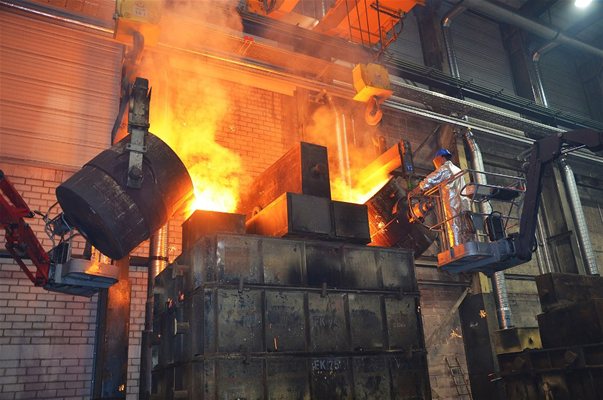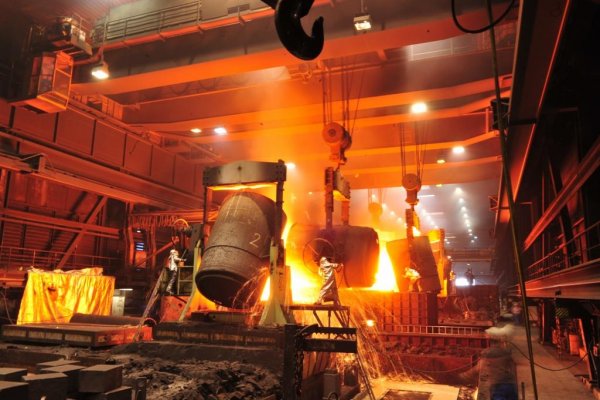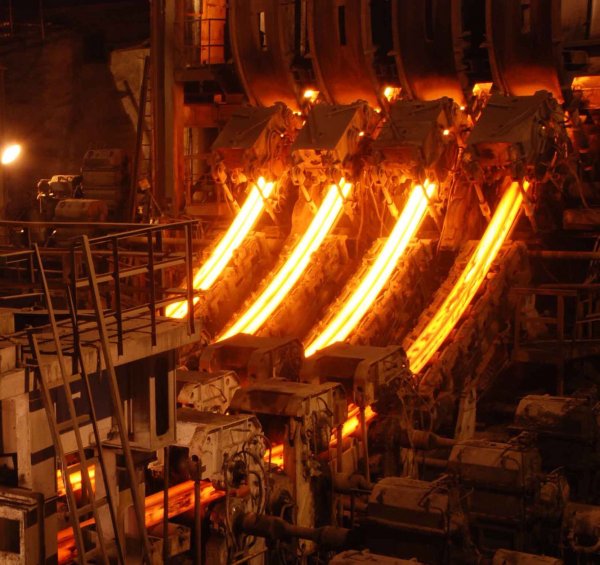Technical means of measurement and control in foundry
Improving the efficiency and quality of casting process control is related to solving the problems of measurement and control of various technological parameters that affect the course of processes or are the main quality indicators. Such parameters in a foundry include:
-
level of charging of charged materials in smelting plants, as well as in hoppers of departments for the preparation of mixture and mixture;
-
level of liquid metal in casting molds;
-
mass, consumption, density, concentration and chemical composition of various materials;
-
moisture, temperature, fluidity or formability of mixtures;
-
chemical composition and temperature of melts, etc.
The control of these parameters is difficult, because in addition to the usual requirements for accuracy, speed, sensitivity, stability of characteristics imposed on all sensors, for sensors installed in foundries, additional requirements are required for strength, resistance to aggressive materials, high temperatures, dust, vibrations, etc.
The control of the most important technological parameters in casting processes is not fully resolved, and further development of new methods and means of measurement and control is necessary, using the results of statistical studies, the calculation of parameters by indirect indicators using controllers, modern computer technologies, etc.
Level sensors
Foundry Material Level Sensors They are widely used in control systems for preparing and charging a charge in melting units, preparing a mixture and pouring melts into molds.
The main requirement for level sensors is high operational reliability, since false operation or failure leads to an emergency situation in the technological process: overflow or emptying of containers, melting units, overflow or underfilling of metals in the mold, etc.
In control systems for preparation of charging and charging of melting units in a foundry, use ramrod, winch, lever, contact, thermostatic, photoelectric and other level sensors.
Level sensor the charge is structurally made in the form of a steel ramrod moving in the controlled cavity of the turret. The piston is articulated with a rocker, which is driven by an electromagnet and returns to its original position by a spring.
When voltage from the motor is applied to the electrical circuit, a cam rotates, which periodically closes the contact located in the intermediate relay circuit. The relay, when actuated, turns on an electromagnet that brings the cleaning rod into the controlled area of the dome.
If there is no charge in the controlled space, the piston, as it moves, closes a contact in the signal relay circuit, which issues a command pulse to charge the charge in the dome.
Winch level sensor is a rotating block with a flexible cable, at one end of which a load is suspended. The device is mounted in a special hollow bend above the filling window of the dome. To protect the knee from exposure to high temperatures, it is continuously blown with compressed air.
The operation of the sensor and the loading system is blocked in such a way that the unloading of the head begins when the load is lifted, and the lowering of the load begins only after the unloading of the next head.
Lever level sensor consists of a lever mounted in the cast-iron brick of the dome and a rod with a spring at the end of which the starting contacts are mounted. When the dome is fully loaded, the lever enters the cavity of the brick and the contacts open. When the charge descends under the lever, the latter is squeezed by the spring, the contacts close and give a charge signal to the next ear.
The described sensors have a simple design and can be produced in any foundry. However, the presence of moving parts reduces their reliability in conditions of increased temperature, gas pollution and dustiness. More reliable sensors based on the use of physical properties of charged materials and waste gases, they include electrocontact, thermostatic, photoelectric, radioactive, gauges, etc.
Charge level sensor with electrical contact it has a simple design and circuit design, which has led to its wide use in charging systems.
The sensor consists of four contacts, insulated with asbestos packing, mounted in cast iron bricks at the top of the dome masonry. The level of arrangement of the contacts coincides with the specified level of management of the charging materials.
The outer ends of the contacts are connected in pairs and are included in the signal relay circuit. If the charge level is within the specified limits, the contacts across the charge close the signal relay coil circuit. When the level falls below the set value, the relay turns off and gives a signal to charge the batch.
Ur thermostatic sensor Aries the fee is based on the use of the bathroom thermostat. When charging or when the charge level drops during the melting process below a predetermined value, the dome gases are unimpeded, in fact, rise up without entering the thermostat. When the charge will reach a certain control level, the charge layer creates a resistance to the free passage of hot gases up and some gas enters the thermostat channel, which generates a signal to stop the withdrawal.
Radioactive level sensor based on absorption of charge radioactive radiation. Since the absorptive capacity of charging materials is tens of times higher than the absorptive capacity of air, then when the charge falls below the control level, the radiation intensity of the counters increases and the electronic device issues a control signal to the load system. Radioactive cobalt is used as a source of radiation.
Level sensors for bulk and liquid materials in hoppers
They are widely used to control the level of filling and molding materials in hoppers electrode and capacitive signaling devices... The basis of the work of such signaling devices is the dependence of the electrical resistance (electrical capacity) between the electrodes on the properties of the medium.
Conductometric signaling device provides reliable control of the level of bulk materials in hoppers with a resistance of the signal circuit no more than 25 mOhm. Two-electrode signaling devices with two output relays are used for two-position control and level signaling.
In the mixing departments of foundries, along with electronic signaling devices, they use radioactive as well as mechanical level sensors.
Among mechanical sensors, diaphragm sensors are the most common due to their simplicity of design and ease of maintenance.
The diaphragm sensor consists of an elastic element with a clamping frame and micro switches. Install it in the wall botlock. When the level of the controlled material is higher than the clamping frame of the signaling device, the pressure from the material is transferred to the elastic element (membrane), which, being deformed, presses the rod of the closing microswitch ° Csignal circuit.
Sensors for the presence of materials on conveyors
Sensors for the presence of materials on conveyors of flow-transport systems, as well as on belt, aprons, vibrating feeders allow to ensure control and continuous operation of the systems for controlling the dosing and mixing processes.
In melter mixing systems they use electromechanical sensor for the presence of a charge on the feeder, which is a metal comb mounted above the feeder, the plates of which are fixed in hinges and deviate depending on the thickness of the material on the feeder.
Other designs of electromechanical sensors are known, but their use is limited due to the short service life and the need to select the size and material of the probe in each specific case.
Electrical contact sensors (signaling devices) differ from electromechanical ones in increased reliability and interchangeability.
Among non-contact sensors, they occupy a special place capacitive sensors for the presence of material on the conveyor, characterized by a simple design of the sensitive element and high reliability.
The sensitive element of the capacitive sensor consists of two flat insulated metal plates mounted flush under the conveyor belt. As a measuring circuit, as a rule, an autogenerator is used, in the feedback circuit of which a sensitive element is connected.
When material appears on the conveyor belt, the capacitance of the sensitive element changes, which causes the oscillations of the oscillator to break and activate the signal relay.
Mold filling control sensors
The control system for the process of pouring liquid metal into foundry molds It has a counter with a large value and form filling.
Electromagnetic sensor is an electromagnet with its relay coil included in the circuit. Place it on the form Oh... When filling the mold, the metal rises and fills the groove closed along the contour.
When alternating current flows through the coil of an electromagnet in a closed loop of liquid metal, an EMF is induced and a magnetic field appears interacting with the electromagnet's field. This changes the inductive resistance of the coil and the output relay gives a signal to complete the mold and stop casting.
Photometric sensor includes an infrared filter installed above the output of the form, a receiver and an amplifier with a signal relay.
When filling the form of liquid metal, hitting the light rays of the light filter and then to the receiver. The output signal of the receiver is amplified by the amplifier and fed to the coil of the signal relay, which issues the appropriate command to the charging system. The sensors are effective when used to control the filling of sand-clay molds with high metal content.
Humidity sensors
Vague sensors are used in mixing process control systems to obtain molding and core sands with certain technological properties.
Conductometric data maternal humidity made in the form of a metal probe installed in the runners or in the hopper. Using the sensor together with temperature correction devices allows stabilization of the mixture properties.
Capacitive humidity sensorand is a capacitor whose electrodes are the rollers of the runners and a metal ring, isolated from the body of the runners, mounted in a groove bottom runners along the inner diameter of rotation of their rollers.
For continuous automatic control of moisture content in moving materials, capacitive flow sensors are of interest, which make it possible to provide non-contact measurement of moisture content in moving materials.
It should be noted that the existing electrical control methods (conductometric, capacitive, inductive, etc.) can be used only in cases where factors such as the composition of the grain size of the mixture, the content of the binder and additives, the uniformity of their distribution, degree of compaction and temperature remain constant.
Achieving the constancy of these parameters in the absence of systems for the preparation and stabilization of the properties of the starting materials allows methods of quality control of the molding sand during its preparation according to the main technological properties: molding, compaction, fluidity, fluidity, etc.

Temperature sensors
To control the temperature of the liquid mmetals widely use contact and non-contact methods. Application-based measurements immersion thermocouple and pyrometers of different designs.
Submersible thermocouplesdesigned for long-term use, contain thermocoupleNS protective coating and water-cooled fittings. Thermoelectrodes are usually made of platinum wire.
The auto-driven thermocouple gives good reproducibility of readings with repeated, intermittent use without changing the thermal junction and protective cap. In most cases, these thermocouples are used to control the temperature of the molten steel bath in electric furnaces.
Measuring the temperature of liquid melts by contact methods (immersion thermocouples) is difficult due to insufficient resistance of the protective tips, changes in the calibration characteristics of the thermocouple, and other reasons. Also, in shortvPeriodic measurements of the belt cannot give a correct idea of the temperature state of the entire mass of liquid iron.
That is why they are widespread in the foundry non-contact temperature control methods, which makes it possible to carry out long-term continuous measurements and use their results in control systems.
Industrial introduction of non-contact methods allows you to exclude influence on the measurement results of slag and other films on the surface of cast iron, as well as the parameters of the intermediate medium (dustiness, gas content, etc.). Use for non-contact temperature measurement pyrometersthis view of the stream or metal surface depends on the location of the melter or ladle.
Sensors for chemical composition
V foundry the most widespread are the chemical and physico-chemical methods for controlling the chemical composition of alloys.
In order to reduce the duration of preparatory operations and analyses, organizational and technical measures are developed to speed up the analysis process.
In this light, questions about the mechanization and automation of sample preparation, their transportation to the laboratory, as well as the creation of devices for recording and transmitting analytical data to management systems become particularly important.
Along with chemical and physico-chemical methods, in recent years physical methods are used for express analysis: thermographic, spectral, magnetic, etc.




